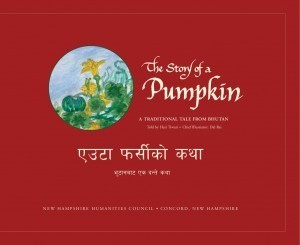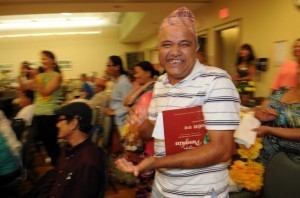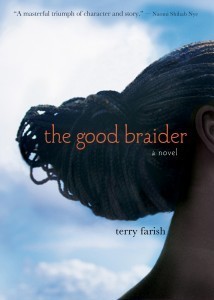Terry Farish's Blog, page 23
November 10, 2014
From a Bhutanese Farm to Small-Town America: A Folktale Journeys with its Tellers
 My article, “From a Bhutanese Farm to Small-Town America: A Folktale Journeys with its Tellers” was published in Bookbird, A Journal of
My article, “From a Bhutanese Farm to Small-Town America: A Folktale Journeys with its Tellers” was published in Bookbird, A Journal of

International Chidlren’s Literature. Creating the Nepali-English folktale, The Story of a Pumpkin, was a many-layered process, challenging, and joyous, too. The link above is to an excerpt of the article. I tried to bring readers through our steps and introduce you to all who made the book happen from the refugee community we worked with to ESOL teachers to the brilliant, creative women of the New Hampshire Humanities Council. Deb Cram took the photos of the dancing girls in Manchester at the Humanities Council folktale festival where we launched The Story of a Pumpkin. The book is distributed by the University Press of New England. I just saw a notice of the book in a Miami newspaper. May this story keep on rolling and coming into its own, which is just what happens to its magical hero.
September 15, 2014
IBBY Congress in Mexico City Honors Stories Around the World
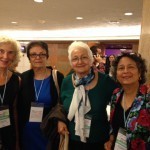

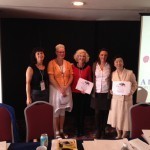

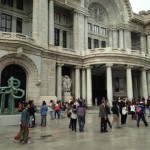
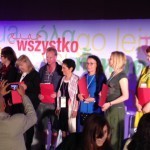
How proud the people of IBBY Mexico were to bring creators of children’s literature and educators from all over the world to Mexico City. They showed us palaces beyond beauty, feted us with tequila and tiny hordeuves with hibiscus at galas, seduced us with the art of Mexican illustrators. The word seduction was the word of the conference to me. A long discussion by – is this term a little too close to the language of marketing? – the creatives – brought a very pointed rebuke to some. Reading, the creatives on the dais said, must not be a slogan for literacy, must not be a lesson twenty minutes a day, you idiots. No, the creatives said, reading is a journey into seduction. My paraphrase. But this is my story, too. Every book is a falling in love. This past summer I read one book, over and over. When I was driving, I listened to the audio of this book. I loved this book. This is not the first time I’ve done this with a story. Yes, reading must be a seduction.
These writers were sharp in their rebellions against the industry. Juan Domingo Arguelles suggested Crime and Punishment would not be published today. Now we must have values in our books. In his hyperbolic way he assured us, “My books have no values.” He had been given a list by a U.S. publisher of 34 things his books must not mention, he said. What are the the taboos imposed, perhaps not articulated, but observed, that publishers perceive as making a book inappropriate, unmarketable? What are taboos observed across culture? I am drawn to dig deeper into these issues and welcome interpretations by others. We do know that the CBC clarified U.S. publishing restrictions based on race in their recent study finding that less that 10% of books feature stories about nonwhites.
Almost 1,000 advocates for using children’s literature as a bridge among cultures and nations were all TOGETHER. Here’s a quote from David Almond who was there and whose books awe me. He said, “Every time a child is born the universe is re-created.” This expressed value is one that gives me a sense of possibility for our work as creators of books for the young.
In this Mexico City conference I found a remarkable addition to conferences I have not seen in the U.S. In every session, a technician staffed the media console. Whatever your presentation, the technician mastered it. All presentations worked flawlessly. I brought a Keynote on ipad. Bueno. In Mexico City, for an audience of people from Mexico, Bolivia, Sweden, Japan, Slovenia, Ireland, Texas, and more I played a video of a rap song written and performed by a South Sudanese-American rap star OD Bony from Portland, Maine. Imagine.
A young man from Gran Bretana working on a PhD presented his research in a poster session. It think the title of his presentation speaks to the soul of IBBY. His title was, “The Potential Role of Children’s Literature in Developing Tolerance Between Turkish and Kurdish Students.” In light of political breakdowns in the home countries of many who joined here, people came for the hope in children and their books.
IBBY Congress in Mexico City






How proud the people of IBBY Mexico were to bring creators of children’s literature and educators from all over the world to Mexico City. They showed us palaces beyond beauty, feted us with tequila and tiny hordeuves with hibiscus at galas, seduced us with the art of Mexican illustrators. The word seduction was the word of the conference to me. A long discussion by – is this term a little too close to the language of marketing? – the creatives – brought a very pointed rebuke to some. Reading, the creatives on the dais said, must not be a slogan for literacy, must not be a lesson twenty minutes a day, you idiots. No, the creatives said, reading is a journey into seduction. My paraphrase. But this is my story, too. Every book is a falling in love. This past summer I read one book, over and over. When I was driving, I listened to the audio of this book. I loved this book. This is not the first time I’ve done this with a story. Yes, reading must be a seduction.
These writers were sharp in their rebellions against the industry. Juan Domingo Arguelles suggested Crime and Punishment would not be published today. Now we must have values in our books. In his hyperbolic way he assured us, “My books have no values.” He had been given a list by a U.S. publisher of 34 things his books must not mention, he said. What are the the taboos imposed, perhaps not articulated, but observed, that publishers perceive as making a book inappropriate, unmarketable? What are taboos observed across culture? I am drawn to dig deeper into these issues and welcome interpretations by others. We do know that the CBC clarified U.S. publishing restrictions based on race in their recent study finding that less that 10% of books feature stories about nonwhites.
Almost 1,000 advocates for using children’s literature as a bridge among cultures and nations were all TOGETHER. Here’s a quote from David Almond who was there and whose books awe me. He said, “Every time a child is born the universe is re-created.” This expressed value is one that gives me a sense of possibility for our work as creators of books for the young.
In this Mexico City conference I found a remarkable addition to conferences I have not seen in the U.S. In every session, a technician staffed the media console. Whatever your presentation, the technician mastered it. All presentations worked flawlessly. I brought a Keynote on ipad. Bueno. In Mexico City, for an audience of people from Mexico, Bolivia, Sweden, Japan, Slovenia, Ireland, Texas, and more I played a video of a rap song written and performed by a South Sudanese-American rap star OD Bony from Portland, Maine. Imagine.
A young man from Gran Bretana working on a PhD presented his research in a poster session. It think the title of his presentation speaks to the soul of IBBY. His title was, “The Potential Role of Children’s Literature in Developing Tolerance Between Turkish and Kurdish Students.” In light of political breakdowns in the home countries of many who joined here, people came for the hope in children and their books.
September 3, 2014
OD Sings the South Sudanese Diaspora
OD Bonny has just released his newest album, Apwoyo – Thank you. It is full of fire – an Acholi-English rap. Here it is:
An Open Book Foundation, Washington, D.C.
 I’m going to Washington, D.C. with The Good Braider through An Open Book Foundation. An Open Book offers this generous invitation to D.C. teachers and librarians: “An Open Book Foundation (AOB) brings children’s and teens’ authors into your school. We give each student who attends the event a copy of the author’s book to take home, a copy of the book to each classroom, and a set of the author’s books to the school library. This fabulous experience opens up the world of reading to your students. They can’t wait to open their new books.” I am very, very excited to bring this story to students here.
I’m going to Washington, D.C. with The Good Braider through An Open Book Foundation. An Open Book offers this generous invitation to D.C. teachers and librarians: “An Open Book Foundation (AOB) brings children’s and teens’ authors into your school. We give each student who attends the event a copy of the author’s book to take home, a copy of the book to each classroom, and a set of the author’s books to the school library. This fabulous experience opens up the world of reading to your students. They can’t wait to open their new books.” I am very, very excited to bring this story to students here.
July 25, 2014
The Good Braider is part of YWCA Hartford Region’s “A Week Without Violence”
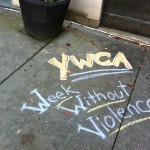 In honor of YWCA’s national movement, a Week Without Violence, YWCA Hartford Region has invited me to tell the story behind The Good Braider in an evening that also features young refugees and survivors of violence. I am deeply honored to bring Viola’s story tothe YWCA Hartford program entitled, “Rising Above: Stories of Female Survivors” on Oct. 15.
In honor of YWCA’s national movement, a Week Without Violence, YWCA Hartford Region has invited me to tell the story behind The Good Braider in an evening that also features young refugees and survivors of violence. I am deeply honored to bring Viola’s story tothe YWCA Hartford program entitled, “Rising Above: Stories of Female Survivors” on Oct. 15.
The Good Braider is part of Hartford’s YWCA “Rising Above” event honoring refugees
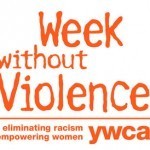
Week of October 13th, 2014
The YWCA will recognize the courage of girls and women this October, as the organization does each October. The Hartford YWCA has invited me to tell the story behind writing The Good Braider in an evening that also features young refugees and survivors of violence. I am deeply honored to bring Viola’s story to the YWCA program entitled, “Rising Above: Stories of Female Survivors.” 
The Good Braider going to Hartford

Week of October 13th, 2014
The YWCA will recognize “A Week Without Violence” this October, as the organization does each October. The Hartford YWCA has invited me to tell the story behind writing The Good Braider in an evening that also features young refugees and survivors of violence. I am deeply honored to bring Viola’s story to “A Week Without Violence” this fall.
June 1, 2014
My Writing Process ~ The Blog Tour
My Writing Process ~ The Blog Tour
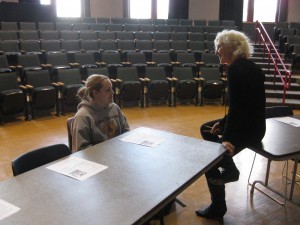
With a student, facing the blank page
Thank you to journalist Barbara Beckwith for inviting me to the Writing Process Blog Tour that features posts by writers of all kinds. We have each responded to the four questions below. Follow the tour at #writingprocessblogtour
What Am I Working On?
I’m doing revisions of a young adult novel currently called, RABBIT IN THE MOON - about a New Hampshire fisherman’s daughter. When the daughter, Sofie, falls in love with a soldier, she’s pulled into the truth of a story she’s spent her life denying – that she is also a daughter of Cambodia. Her Cambodian mother has not been in her life and the novel is an exploration of family and openings to human connection. Carolrhoda Lab will publish the book in fall, 2015.
How Does My Work Differ from Others of its Genre?
I’m interested in stories of people who have found haven in the U.S. after displacement from their home country due to war or extreme poverty. I’m also very interested in stories of the home countries of new Americans, both as a reader and a writer.
Why Do I Write What I Do?
My first job out of college was working for the American Red Cross in Vietnam during the war, and I’ve found that that experience opened me to life-long curiosity, research, and writing about war and refugees and immigrants to the U.S. I have often written across cultures. I am compelled to try to step into the shoes of people unlike myself; trying to imagine other lives is the reason I write. Barbara Beckwith’s work in the field of white privilege, explorations of racial identity in the U.S., and institutional racism has offered me perspective on questions of race. I think this is a life-long process of discovery.
How Does My Writing Process Work?
Right now I’m in the beginning steps of entering a new novel. I’ve spent the last several years rewriting two novels that took different forms. One was THE GOOD BRAIDER, the story of a girl from South Sudan; the second is RABBIT IN THE MOON. I have never been able to let a book go. I need to stay with it as it struggles to find out what it is. Now, I’m with brand new material. I have tons of books I pour through. I’m also working with my mother’s teen-age journals. I’m beginning with scenes. I write the scenes as a poem or a short story or entries in my journal. I have a journal that is devoted to this new novel. My way into the novel seems to be almost like a process of collecting small jewels which eventually I’ll try to arrange into a pattern.
Next on this blog tour, please meet nonfiction and memoir writer Kenyi Aruna, poet Susan Roney-O’ Brien and novelist and short story writer, John Mort.
Kenyi Aruna’s first book, a memoir of his life as a child during the war in Sudan, is called BETWEEN TWO RIVERS. Kenyi also wrote a short memoir, “The Photograph” collected in the book, I REMEMBER WARM RAIN: 15 TEENAGERS, 15 COMING OF AGE STORIES. The book is published by The Telling Room in Portland, Maine and is a book I have taken into classrooms whenever I do writing workshops with students. It’s a beautifully done, honest book. Kenyi is a new graduate of the University of Maine, Farmington and has launched a nonprofit, The Sudanese School Lunch Program, to aid children in his home village to receive food during the days they are at school.
Susan Roney O’Brien documents her life – and human life – with poems, from discoveries of motherhood, to painful losses, to journeys of many kinds. Her collections include Farmwife and Earth and her poems have appeared in Prairie Schooner and the Christian Science Monitor to name only a few. Her awards are numerous including being named the New England Association of Teachers of English “Poet of the Year.”
John Mort has steadily contributed works to the canon of literature of the Vietnam war. His books include Tanks, Soldier in Paradise, and The Illegal. He studied at the University of Iowa and reviewed books for The American Library Association’s journal, Booklist. He might be most proud, though, of his field of peach trees at his farm in Missouri.
Writing Process Blog Tour
Writing Process Blog Tour: Terry Farish
Thank you to journalist Barbara Beckwith for inviting me to the Writing Process Blog Tour that features posts by writers of all kinds. We have each responded to the four questions below. Follow the tour at #writingprocessblogtour
What Am I Working On?
I’m doing revisions of a young adult novel currently called, RABBIT IN THE MOON - about a New Hampshire fisherman’s daughter. When the daughter, Sofie, falls in love with a soldier, she’s pulled into the truth of a story she’s spent her life denying – that she is also a daughter of Cambodia. Her Cambodian mother has not been in her life and the novel is an exploration of family and openings to human connection. Carolrhoda Lab will publish the book in fall, 2015.
How Does My Work Differ from Others of its Genre?
I’m interested in stories of people who have found haven in the U.S. after displacement from their home country due to war or extreme poverty. I’m also very interested in stories of the home countries of new Americans, both as a reader and a writer.
Why Do I Write What I Do?
My first job out of college was working for the American Red Cross in Vietnam during the war, and I’ve found that that experience opened me to life-long curiosity, research, and writing about war and refugees and immigrants to the U.S. I have often written across cultures. I am compelled to try to step into the shoes of people unlike myself; trying to imagine other lives is the reason I write. Barbara Beckwith’s work in the field of white privilege, explorations of racial identity in the U.S., and institutional racism has offered me perspective on questions of race. I think this is a life-long process of discovery.
How Does My Writing Process Work?
Right now I’m in the beginning steps of entering a new novel. I’ve spent the last several years rewriting two novels that took different forms. One was THE GOOD BRAIDER, the story of a girl from South Sudan; the second is RABBIT IN THE MOON. I have never been able to let a book go. I need to stay with it as it struggles to find out what it is. Now, I’m with brand new material. I have tons of books I pour through. I’m also working with my mother’s teen-age journals. I’m beginning with scenes. I write the scenes as a poem or a short story or entries in my journal. I have a journal that is devoted to this new novel. My way into the novel seems to be almost like a process of collecting small jewels which eventually I’ll try to arrange into a pattern.
Next on this blog tour, please meet poet Susan Roney-O’ Brien and novelist and short story writer, John Mort.
Susan Roney-O’Brien documents her life – and human life – with poems, from discoveries of motherhood, to painful losses, to journeys of many kinds. Her collections include Farmwife and Earth and her poems have appeared in Prairie Schooner and the Christian Science Monitor to name only a few. Her awards are numerous including being named the New England Association of Teachers of English “Poet of the Year.”
John Mort has steadily contributed works to the canon of literature of the Vietnam war. His books include Tanks, Soldier in Paradise, and The Illegal. He studied at the University of Iowa and reviewed books for The American Library Association’s journal, Booklist. He might be most proud, though, of his field of peach trees at his farm in Missouri.

